
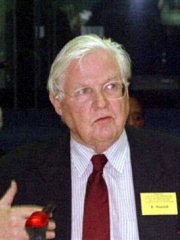
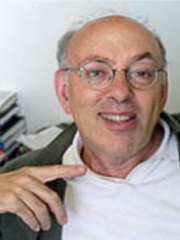
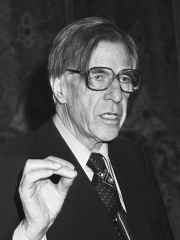
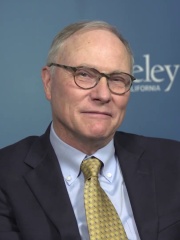
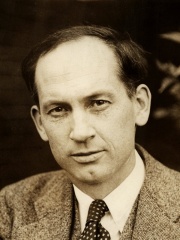
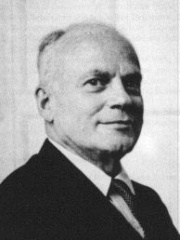
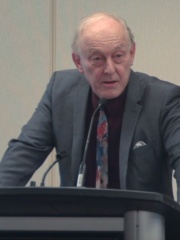
The Most Famous
ECONOMISTS from Canada
This page contains a list of the greatest Canadian Economists. The pantheon dataset contains 414 Economists, 9 of which were born in Canada. This makes Canada the birth place of the 8th most number of Economists behind Russia, and Poland.
Top 9
The following people are considered by Pantheon to be the most legendary Canadian Economists of all time. This list of famous Canadian Economists is sorted by HPI (Historical Popularity Index), a metric that aggregates information on a biography's online popularity.

1. William Vickrey (1914 - 1996)
With an HPI of 69.83, William Vickrey is the most famous Canadian Economist. His biography has been translated into 53 different languages on wikipedia.
William Spencer Vickrey (21 June 1914 – 11 October 1996) was a Canadian-American professor of economics. He was a lifelong faculty member at Columbia University. A theorist who worked on public economics and mechanism design, Vickrey primarily discussed public policy problems. He originated the Vickrey auction, introduced the concept of congestion pricing in networks, formalized arguments for marginal cost pricing, and contributed to optimal income taxation. James Tobin described him as "an applied economist's theorist, as well as a theorist's applied economist." Vickrey was awarded the 1996 Nobel Memorial Prize in Economic Sciences with James Mirrlees for their research into the economic theory of incentives under asymmetric information. Vickrey never personally received the Prize; it was announced just three days prior to his death.

2. Robert Mundell (1932 - 2021)
With an HPI of 69.46, Robert Mundell is the 2nd most famous Canadian Economist. His biography has been translated into 52 different languages.
Robert Alexander Mundell (October 24, 1932 – April 4, 2021) was a Canadian economist. He was a professor of economics at Columbia University and the Chinese University of Hong Kong. He received the Nobel Memorial Prize in Economic Sciences in 1999 for his pioneering work in monetary dynamics and optimum currency areas. Mundell is known as the "father" of the euro, as he laid the groundwork for its introduction through this work and helped to start the movement known as supply-side economics. Mundell was also known for the Mundell–Fleming model and Mundell–Tobin effect.

3. Henry Mintzberg (b. 1939)
With an HPI of 67.97, Henry Mintzberg is the 3rd most famous Canadian Economist. His biography has been translated into 28 different languages.
Henry Mintzberg is a Canadian academic and author on business and management. He is currently the Cleghorn Professor of Management Studies at the Desautels Faculty of Management of McGill University in Montreal, Quebec, Canada, where he has been teaching since 1968.

4. John Kenneth Galbraith (1908 - 2006)
With an HPI of 67.93, John Kenneth Galbraith is the 4th most famous Canadian Economist. His biography has been translated into 54 different languages.
John Kenneth Galbraith (October 15, 1908 – April 29, 2006), also known as J. K. Galbraith or Ken Galbraith, was a Canadian-American economist, diplomat, public official, and intellectual. His books on economic topics were bestsellers from the 1950s through the 2000s. As an economist, he leaned toward post-Keynesian economics from an institutionalist perspective. He served as the deputy director of the powerful Office of Price Administration (OPA) during World War II in charge of stabilizing all prices, wages and rents in the American economy, to combat the threat of inflation and hoarding during a time of shortages and rationing, a task which was successfully accomplished. Galbraith was a long-time Harvard faculty member and stayed with Harvard University for half a century as a professor of economics. He was a prolific author and wrote four dozen books, including several novels, and published more than a thousand articles and essays on various subjects. Among his works was a trilogy on economics, American Capitalism (1952), The Affluent Society (1958), and The New Industrial State (1967). Galbraith was active in Democratic Party politics, serving in the administrations of Franklin D. Roosevelt, Harry S. Truman, John F. Kennedy, and Lyndon B. Johnson. He served as United States Ambassador to India under the Kennedy administration. His political activism, literary output and outspokenness brought him wide fame during his lifetime. Galbraith was one of the few to receive both the World War II Medal of Freedom (1946) and the Presidential Medal of Freedom (2000) for his public service and contributions to science.
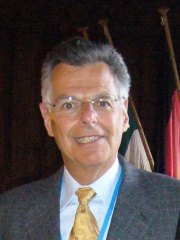
5. Myron Scholes (b. 1941)
With an HPI of 62.62, Myron Scholes is the 5th most famous Canadian Economist. His biography has been translated into 49 different languages.
Myron Samuel Scholes ( SHOHLZ; born July 1, 1941) is a Canadian–American financial economist. Scholes is the Frank E. Buck Professor of Finance, Emeritus, at the Stanford Graduate School of Business, Nobel Laureate in Economic Sciences, and co-originator of the Black–Scholes options pricing model. This mathematical model, developed with Fischer Black, revolutionized finance by providing a systematic way to value options through the elimination of risk via dynamic hedging. In 1997, Scholes was awarded the Nobel Memorial Prize in Economic Sciences (shared with Robert C. Merton) for a "new method to determine the value of derivatives." The Royal Swedish Academy of Sciences noted that their work made it possible to observe the value of options in a scientific manner, effectively creating a foundation for the rapid growth of financial markets and the management of economic risk across the globe. Scholes is currently the Chief Investment Strategist at Janus Henderson. Previously he served as the chairman of Platinum Grove Asset Management and on the Dimensional Fund Advisors board of directors, American Century Mutual Fund board of directors, chairman of the Board of Economic Advisers of Stamos Capital Partners, and the Cutwater Advisory Board. He was a principal and limited partner at Long-Term Capital Management (LTCM), a highly leveraged hedge fund that collapsed in 1998, and a managing director at Salomon Brothers. Other positions Scholes held include the Edward Eagle brown Professor of Finance at the University of Chicago, senior research fellow at the Hoover Institution, director of the Center for Research in Security Prices, and professor of finance at MIT's Sloan School of Management. Scholes earned his PhD at the University of Chicago.

6. David Card (b. 1956)
With an HPI of 57.95, David Card is the 6th most famous Canadian Economist. His biography has been translated into 40 different languages.
David Edward Card (born 1956) is a Canadian-American labour economist and the Class of 1950 Professor of Economics at the University of California, Berkeley, where he has been since 1997. He was awarded half of the 2021 Nobel Memorial Prize in Economic Sciences "for his empirical contributions to labour economics", with Joshua Angrist and Guido Imbens jointly awarded the other half.

7. Harold Innis (1894 - 1952)
With an HPI of 56.76, Harold Innis is the 7th most famous Canadian Economist. His biography has been translated into 24 different languages.
Harold Adams Innis (November 5, 1894 – November 8, 1952) was a Canadian professor of political economy at the University of Toronto and the author of seminal works on media, communication theory, and Canadian economic history. He helped develop the staples thesis, which holds that Canada's culture, political history, and economy have been decisively influenced by the exploitation and export of a series of "staples" such as fur, fish, lumber, wheat, mined metals, and coal. The staple thesis dominated economic history in Canada from the 1930s to 1960s, and continues to be a fundamental part of the Canadian political economic tradition. Innis has been referred to as the "father of communications theory" and as the "father of Canadian economic history". Innis's writings on communication explore the role of media in shaping the culture and development of civilizations. He argued, for example, that a balance between oral and written forms of communication contributed to the flourishing of Greek civilization in the 5th century BC. He warned, however, that Western civilization is now imperiled by powerful, advertising-driven media obsessed by "present-mindedness" and the "continuous, systematic, ruthless destruction of elements of permanence essential to cultural activity." His intellectual bond with Eric A. Havelock formed the foundations of the Toronto School of communication theory, which provided a source of inspiration for future members of the school Marshall McLuhan and Edmund Snow Carpenter. Innis laid the basis for scholarship that looked at the social sciences from a distinctly Canadian point of view. As the head of the University of Toronto's political economy department, he worked to build up a cadre of Canadian scholars so that universities would not continue to rely as heavily on British or American-trained professors unfamiliar with Canada's history and culture. He was successful in establishing sources of financing for Canadian scholarly research. As the Cold War grew hotter after 1947, Innis grew increasingly hostile to the United States. He warned repeatedly that Canada was becoming a subservient colony to its much more powerful southern neighbor. "We are indeed fighting for our lives", he warned, pointing especially to the "pernicious influence of American advertising.... We can only survive by taking persistent action at strategic points against American imperialism in all its attractive guises." His views influenced some younger scholars, including Donald Creighton. Innis also tried to defend universities from political and economic pressures. He believed that independent universities, as centres of critical thought, were essential to the survival of Western civilization. His intellectual disciple and university colleague, Marshall McLuhan, lamented Innis's premature death as a disastrous loss for human understanding. McLuhan wrote: "I am pleased to think of my own book The Gutenberg Galaxy as a footnote to the observations of Innis on the subject of the psychic and social consequences, first of writing then of printing." Mel Watkins declared that Innis was "without doubt the most distinguished social scientist and historian, and one of the most distinguished intellectuals, that Canada has ever produced".

8. Jacob Viner (1892 - 1970)
With an HPI of 54.18, Jacob Viner is the 8th most famous Canadian Economist. His biography has been translated into 17 different languages.
Jacob Viner (3 May 1892 – 12 September 1970) was a Canadian economist and is considered with Frank Knight and Henry Simons to be one of the "inspiring" mentors of the early Chicago school of economics in the 1930s: he was one of the leading figures of the Chicago faculty. Paul Samuelson named Viner (along with Harry Gunnison Brown, Allyn Abbott Young, Henry Ludwell Moore, Frank Knight, Wesley Clair Mitchell, and Henry Schultz) as one of the several "American saints in economics" born after 1860. He was an important figure in the field of political economy.

9. Michel Chossudovsky (b. 1946)
With an HPI of 53.64, Michel Chossudovsky is the 9th most famous Canadian Economist. His biography has been translated into 17 different languages.
Michel Chossudovsky (born 1946) is a Canadian economist and author. He is professor emeritus of economics at the University of Ottawa and the president and director of the Centre for Research on Globalization (CRG), which runs the website globalresearch.ca, founded in 2001, which publishes falsehoods and conspiracy theories. Chossudovsky has promoted conspiracy theories about 9/11. In 2017, the Centre for Research on Globalization was accused by information warfare specialists at NATO’s Strategic Communications Centre of Excellence (STRATCOM) of playing a key role in the spread of pro-Russian propaganda. A report by the U.S. State Department in August 2020 accused the website of being a proxy for a Russian disinformation campaign.
People
Pantheon has 9 people classified as Canadian economists born between 1892 and 1956. Of these 9, 4 (44.44%) of them are still alive today. The most famous living Canadian economists include Henry Mintzberg, Myron Scholes, and David Card. The most famous deceased Canadian economists include William Vickrey, Robert Mundell, and John Kenneth Galbraith.
Living Canadian Economists
Go to all RankingsHenry Mintzberg
1939 - Present
HPI: 67.97
Myron Scholes
1941 - Present
HPI: 62.62
David Card
1956 - Present
HPI: 57.95
Michel Chossudovsky
1946 - Present
HPI: 53.64
Deceased Canadian Economists
Go to all RankingsWilliam Vickrey
1914 - 1996
HPI: 69.83
Robert Mundell
1932 - 2021
HPI: 69.46
John Kenneth Galbraith
1908 - 2006
HPI: 67.93
Harold Innis
1894 - 1952
HPI: 56.76
Jacob Viner
1892 - 1970
HPI: 54.18
Overlapping Lives
Which Economists were alive at the same time? This visualization shows the lifespans of the 5 most globally memorable Economists since 1700.

